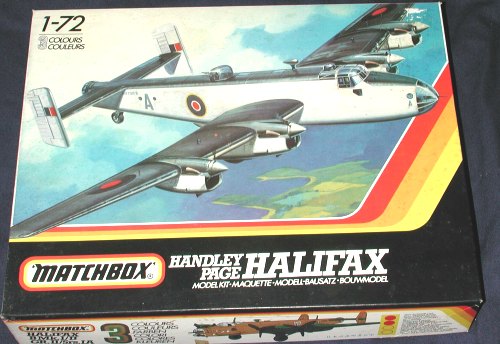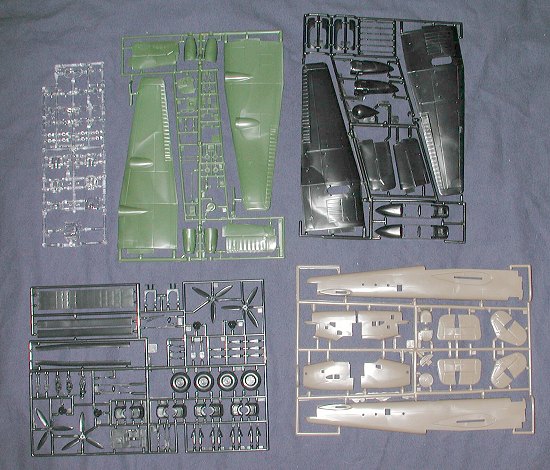
|
KIT: |
Matchbox 1/72 Halifax |
|
KIT # |
PK 604 |
|
PRICE: |
? |
|
DECALS: |
3 options |
|
REVIEWER: |
|
|
NOTES: |

|
HISTORY |
|
THE KIT |

Molded in brown, black and dark green, this is as typical a Matchbox kit as you could find. Finely raised panel lines are intermixed with trenches where the engraved bits are located. The general level of detail is simple as befits most Matchbox kits. The cockpit, for example, consists of generic seats, control columns and pilots. There is some black box detail in the radio operator's compartment, but the thickness of the clear bits will distort any attempt at detailing this section.
The kit offers separate bomb bay doors, but I don't see any bomb load. The engines appear to be a rather complex construct, but should provide no real challenges to an experienced modeler. There are options for several different variants of the Merlin-powered Halifax that include new noses and the ability to add or delete turrets as needed. Two different fin styles are also provided.
Instructions are well done in the standard pictorial style. As is the
norm with Matchbox, all the detail painting is provided in a separate
section. Generic colors are used as well as Humbrol numbers, though these
may be from an earl ier
series so one needs to be careful in that regard. Any differences between
variants is noted in the construction sequences.
ier
series so one needs to be careful in that regard. Any differences between
variants is noted in the construction sequences.
Marking options are for three aircraft. First is the box art aircraft, a GR.II from 58 Sq of Coastal Command during 1943 in 'sea grey over white'. This aircraft has the non-turreted nose, upper and tail turrets with the radome on the underside. It also has the larger 'square' fins. Next is a B.I from 76 Squadron during June of 1941 in Dark Earth/Dark Green over Black. It has the nose turret and tail turret with no upper turret. It carries the early 'arrow' fins. A very similar B.II from 10 Sq during 1942 is the third option. Colors are the same as the previous aircraft. Decals are well printed, though a bit thick. Despite their age, they should perform well.
|
CONCLUSIONS |
This is a kit one sees built rarely. Face it, Matchbox kits don't usually do well in contests as the builder needs to do a lot of work to bring them up to current standards. There are aftermarket sets that will help. The only other Halifax in 1/72 is the elderly Airfix kit which provides the radial engined version. However, if you'd like a nice bomber model that can be built with some ease (as most Matchbox kits do fit quite well), then this is for you.
If you would like your product reviewed fairly and quickly by a site that has over 200,000 visitors a month, please contact me or see other details in the Note to Contributors.